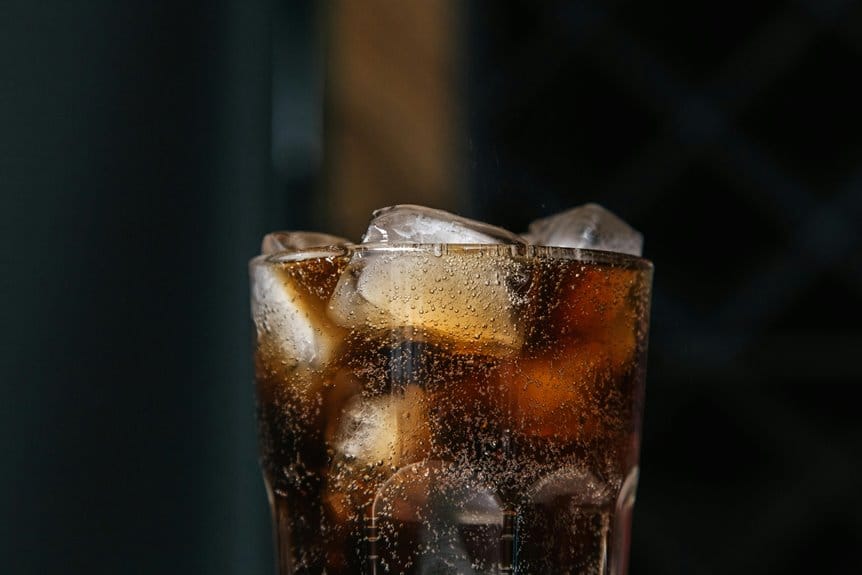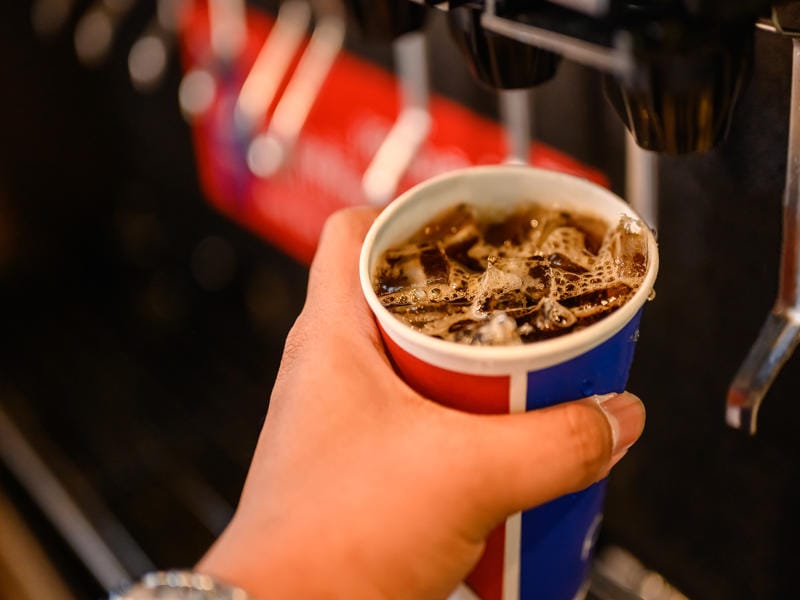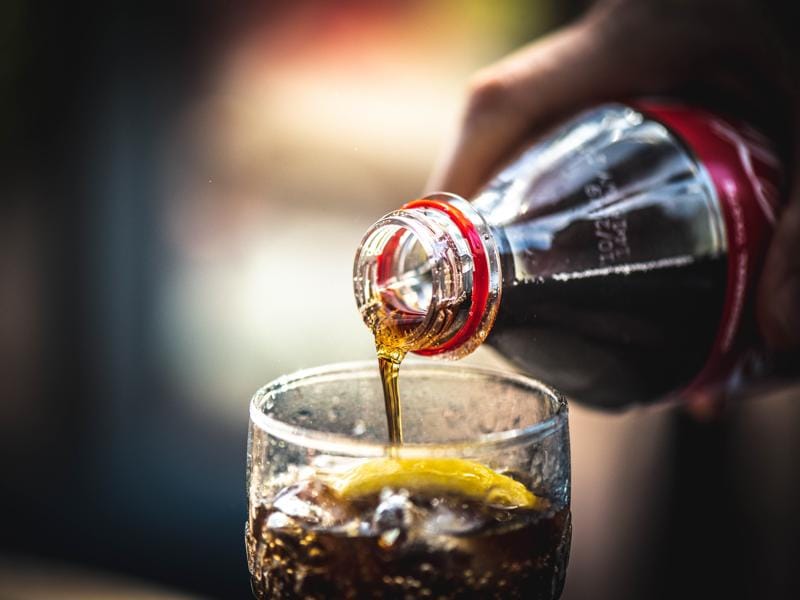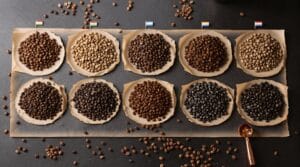Soda and coffee caffeine levels vary widely: 12 oz Coke Zero has 34mg (lowest cola), while coffee ranges from 60mg (instant) to 200mg (bold brews). Sodas average 34-46mg, though Coca-Cola Coffee packs 69mg—rivaling espresso—and energy shots hit 200mg. Chocolate sneaks in caffeine too (60-100mg per cup). The FDA caps daily intake at 400mg; overdoses cause jitters or crashes. Tracking hidden doses (yes, even that ice-cold soda!) helps avoid pitfalls—plus, blending drinks can balance energy without chaos. Uncover smarter sipping tricks ahead!
The Hidden Danger of Caffeine in Everyday Drinks

While millions sip sodas and coffees daily without a subsequent thought, caffeine quietly sneaks into their routines, packing a bigger punch than many realize.
A 12 oz Coke Zero contains 69 mg of caffeine—nearly half the daily limit—while a Coffee Coke blends soda and espresso’s kick in one fizzy can. Darker roasts of coffee often possess lower caffeine levels compared to their lighter counterparts, complicating caffeine management even further.
Regular coffee varies wildly, from 60 mg in instant mixes to 200 mg in bold brews, but soda drinkers often gulp multiple servings, stacking caffeine without noticing.
These “harmless” drinks add up fast, turning pick-me-ups into jittery afternoons or sleepless nights.
Freedom-loving sippers, beware: labels hide numbers that matter. Know your buzz.
Caffeine in Americano coffee might also surprise those who think they are avoiding too much caffeine in sodas.
That “safe” habit might be a stealthy caffeine trap, masquerading as refreshment but hitting like a double-shot—no barista required.
The Fatal Mistake of Underestimating Soda’s Caffeine

Sodas often get a pass as harmless fizzy drinks, but their caffeine content hides a sneaky truth. A typical soda can packs 34-46 mg of caffeine—equivalent to a one-third of coffee’s kick—but that “just one more” mentality adds up fast.
Coca-Cola Coffee blends caffeine even higher, hitting 69 mg per can, a stealthy enhancement masquerading as a sweet treat. Think three colas equal a strong espresso, yet few track how much caffeine in a soda can stacks up daily.
Coca-Cola Coffee packs 69mg caffeine per can—a sugary sleight of hand rivaling espresso’s punch, unnoticed in daily intake tallies.
Add sugary sips between meals, and it’s easy to blow past limits without realizing. For freedom seekers craving energy without chains, understanding these numbers is key: soda’s casual sipping can quietly brew dependency, headaches, and restless nights.
Ignore the fizzy math at your peril.
Surprising Truth: Coke Zero Has Lowest Caffeine

Cracking open a can of Coke Zero might be the smartest move for caffeine-conscious sippers, as it touts the lowest caffeine punch among colas. With just 34 mg per 12 oz, it undercuts rivals like Diet Coke (46 mg) and Pepsi Zero Sugar (69 mg), offering a guilt-free buzz. For those chasing flavor without the jitters, it’s a stealthy winner.
| Cola Choice | Caffeine Per 12 oz |
|---|---|
| Coke Zero | 34 mg |
| Diet Coke | 46 mg |
| Pepsi Zero Sugar | 69 mg |
| Classic Coca-Cola | 34 mg |
| Mountain Dew Zero | 91 mg |
The table reveals Coke Zero’s edge—ideal for late-night sips or steady energy. Its crisp taste, paired with caffeine sovereignty, proves freedom *and* flavor *can* coexist. Sleep troubles? Slim pickings here. Sip smarter, sip lighter, no strings attached.
Golden Formula for Personalized Caffeine Control
| Caffeine Source | mg per Serving | Max Daily Servings (400mg limit) |
|---|---|---|
| Brewed Coffee | 95 | 4 |
| Coca-Cola | 34 | 11 |
| Energy Shot | 200 | 2 |
Keep a caffeine diary (yes, even that afternoon chocolate bar counts). Play scientist: adjust intake based on sleep quality or jitter levels. Remember, “personalized” means no two formulas match—your neighbor’s triple espresso might wreck your zen. Pro tip: hydration and protein-rich snacks soften caffeine’s edge. Additionally, consider that brewing techniques can significantly impact your total caffeine yield, making it essential to choose a method that aligns with your coffee preferences. Now go conquer the day, one calibrated sip at a time.
Smart Drink Blending Strategies
Smart drink blending strategies let people adjust caffeine intake by mixing sodas and coffees in clever ways, like slowly using less regular coffee or matching drinks to how their body reacts.
For those needing a fast energy fix, adding a small coffee shot to low-caffeine soda avoids overdoing it while keeping things tasty. Balancing these methods helps avoid headaches, jitters, or crashes, making daily caffeine habits healthier and more flexible.
- Start with half regular coffee, half decaf to reduce caffeine bit by bit, like easing off a bike’s training wheels.
- Pair herbal tea with a splash of cold brew for a gentle energy lift without the shaky hands.
- Swap sugary sodas for sparkling water plus espresso shots to cut sugar and control caffeine spikes.
- Track drinks in a phone app to spot patterns, like noticing when that additional soda leaves you wired at bedtime.
Gradual Reduction Approach
People looking to cut back on caffeine without shocking their taste buds or energy levels can blend high-caffeine drinks with lower- or no-caffeine options. This method lets drinkers slowly adjust their intake while keeping the flavors they love, like mixing coffee with decaf or cola with caffeine-free soda.
By tweaking ratios over weeks, the body adapts smoothly, avoiding headaches or sudden crashes—think of it as training wheels for your morning brew!
- Start with a 3:1 ratio (3 parts regular coffee or soda to 1 part decaf or caffeine-free), then flip it over 4–6 weeks.
- Blend flavors creatively, like combining cold brew with herbal tea or Coke Zero with fruit seltzer for zing.
- Use “fade-out Fridays”—reduce caffeine strength every Friday until low-caffeine drinks become the new normal.
- Trick your brain with small servings, diluting espresso with hot water or ice to shrink doses without sacrificing ritual.
Sensitivity Management
Balancing caffeine’s kick without the crash? Managing sensitivity starts with blending smarter drink combos, avoiding jitters or energy slumps.
It’s about mixing strengths: low-caffeine sodas with coffee, or spacing intake to match the body’s rhythm.
- Pair sodas (35 mg per Coke) with half-caf coffee, balancing milder caffeine sources for steady energy instead of overwhelming spikes.
- Time caffeine with protein-rich snacks (nuts, yogurt), slowing absorption to extend alertness without overloading receptors.
- Swap one daily coffee for herbal tea, reducing total intake while keeping habitual rituals intact.
- Rotate caffeinated drinks with fruit-infused water, hydrating the body and curbing dependency through flavorful variety.
Freedom lies in tweaking ratios, not bans.
It’s caffeine chess, not checkers—strategic moves keep energy smooth and rebellion-free!
Quick Alertness Solution
Some smart sips can kickstart alertness without the crash, like blending a half-cup of coffee with a low-caffeine soda—say, regular Coke at 35mg per can—to spread the energy evenly. With coffee culture evolving into global social hubs, combining drinks creates a steady buzz, avoiding the spikes from high-caffeine options like energy drinks (160mg in Monster) or black coffee. A light cola mixed with cold brew gives flavor and focus, while diet soda lowers sugar intake.
“Quick hits” could mean sipping small espresso shots (60mg) with bubbly water, too. Timing helps: space sips over an hour, hydrate between, or munch nuts for lasting fuel. Additionally, a blended drink like a Chai Tea Latte from Starbucks can offer a different flavor profile while providing a moderate caffeine boost.
Want fun? Try chilled coffee over ice with *zero-sugar root beer*—sweet, zesty, and crash-free. Freedom comes from tweaking ratios, swapping mixers, and ditching rigid routines. Just skip the triple espressos before naptime.
Become a Caffeine Master
While caffeine keeps the world buzzing, becoming a caffeine master means knowing where it hides, how much packs a punch, and when to hit pause.
Caffeine lurks in sodas like Coke (35 mg per 12 oz), energy drinks (Bang: 300 mg!), and even chocolate, not just coffee (average 60-100 mg per cup).
Three sodas daily can form addiction, so track intake like a pro—spot sneaky sources, read labels, and weigh risks.
Three sodas a day? Even mild habits risk caffeine addiction—track intake, hunt hidden sources, and scan labels to stay in control.
The FDA’s 400 mg daily limit works for most, but headaches, irritability, or racing hearts scream “overdose.”
Balance enhancements by choosing coffee for stronger hits, low-sugar sodas for gentle lifts, or skipping caffeine entirely.
Withdrawal? Ride out the fog—it fades.
Mastery means freedom: decide when to rev up, slow down, or ditch caffeine cold turkey.
Bonus tip: You’re the boss of your buzz, not the other way around! (Cheesy? Maybe. True? Absolutely.)
Frequently Asked Questions
What Are the Caffeine Levels in Different Coke Coffee Flavors?
All Coca-Cola Coffee flavors contain 69 mg caffeine per 12 oz can (5.75 mg per ounce), including Dark Blend, Vanilla, Mocha, and Caramel variants; sugar-free options share identical caffeine levels.
Does Caffeine Content Vary Between Diet and Regular Sodas?
Diet and regular sodas differ in caffeine content. Diet Coke contains 3.5-3.75 mg per ounce compared to regular Coke’s 2.5-3 mg. Caffeine levels vary by formula, with diet versions often containing slightly higher concentrations.
How Does Espresso Compare to Soda in Caffeine Concentration?
Does caffeine truly energize similarly across drinks? Espresso’s concentration surpasses soda dramatically: one ounce of espresso (∼64 mg) contains over 20x the caffeine of an ounce of soda (∼3 mg). Who chooses diluted stimulation when potency empowers freedom?
What Ingredients Contribute to Caffeine in Non-Traditional Coffee Sodas?
Non-traditional coffee sodas derive caffeine primarily from coffee powder or concentrated coffee extracts. Some formulations may include natural caffeine sources like guarana or synthetic additives, depending on the producer’s recipe and regulatory approval.
Are There Low-Caffeine Beverage Options Besides Coke Zero?
Low-caffeine options beyond colas include caffeine-free herbal teas, flavored sparkling waters, most fruit juices, decaffeinated coffee, and non-cola sodas like ginger ale or lemon-lime varieties, offering alternatives with minimal or zero caffeine content.





